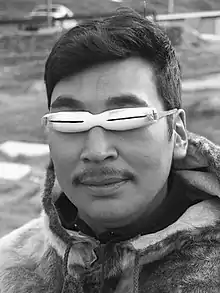Snow goggles
Snow goggles (Inuktitut: ilgaak or iggaak, syllabics: ᐃᓪᒑᒃ or ᐃᒡᒑᒃ;[1] Central Yupik: nigaugek, nigauget) are a type of eyewear traditionally used by the Inuit and the Yupik, formerly known as Eskimo, peoples of the Arctic to prevent snow blindness.[2]
The goggles are traditionally made of driftwood (especially spruce), bone, walrus ivory, caribou antler,[2] or in some cases seashore grass.[3] The workpiece is carved to fit the wearer's face, and one or more narrow horizontal slits are carved through the front.[4] The goggles fit tightly against the face so that the only light entering is through the slits, and soot is sometimes applied to the inside to help cut down on glare.[2][5][6] The slits are made narrow not only to reduce the amount of light entering but also to improve the visual acuity.[2] The greater the width of the slits the larger the field of view.[2]
Terminology
Like other Inuit language words, such as inukhuk/inuksuk,[7][8] a different word may be used in different dialects. In the Kivalliq dialect, ilgaak (ᐃᓪᒑᒃ) is used, while the North Baffin dialect uses iggaak (ᐃᒡᒑᒃ). Both words are also used to refer to sunglasses.[1]
In Central Yup'ik, snow goggles are called nigaugek, while in Cup'ig they are igguag. In Siberian Yupik, the word is iyegaatek.[4]
See also
References
| Wikimedia Commons has media related to Inuit goggles. |
- Asuilaak Living Dictionary - snow goggles
- Inuit Snow Goggles at the Vancouver Maritime Museum
- "Things Made from Grass".
- Smithsonian Institution, St. Lawrence Island Yupik Snow Goggles
- "Snow goggles helped Arctic people survive". December 2007.
- "Yup'ik Snow Goggles". Smithsonian Institution.
- "inuksuk". Asuilaak Living Dictionary. Retrieved 2012-11-22.
- Ohokak, G.; M. Kadlun; B. Harnum. Inuinnaqtun-English Dictionary. Kitikmeot Heritage Society.

_and_Caribou_antler_1000-1800_CE_(bottom).jpg.webp)
